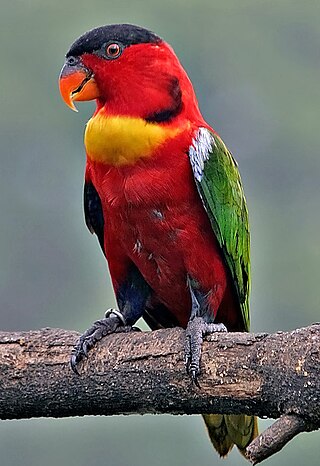Related Research Articles

A cockatoo is any of the 21 species of parrots belonging to the family Cacatuidae, the only family in the superfamily Cacatuoidea. Along with the Psittacoidea and the Strigopoidea, they make up the order Psittaciformes. The family has a mainly Australasian distribution, ranging from the Philippines and the eastern Indonesian islands of Wallacea to New Guinea, the Solomon Islands and Australia.

The red-tailed black cockatoo also known as Banksian- or Banks' black cockatoo, is a large black cockatoo native to Australia. Adult males have a characteristic pair of bright red panels on the tail that gives the species its name. It is more common in the drier parts of the continent. Five subspecies are recognised, differing chiefly in beak size. Although the more northerly subspecies are widespread, the two southern subspecies, the forest red-tailed black cockatoo and the south-eastern red-tailed black cockatoo are under threat.

Rosellas are in a genus that consists of six species and nineteen subspecies. These colourful parrots from Australia are in the genus Platycercus. Platycercus means "broad-tailed" or "flat-tailed", reflecting a feature common to the rosellas and other members of the broad-tailed parrot tribe. Their diet is mainly seeds and fruit.

The Australian king parrot is a species of parrot endemic to eastern Australia ranging from Cooktown in Queensland to Port Campbell in Victoria. Found in humid and heavily forested upland regions of the eastern portion of the continent, including eucalyptus wooded areas in and directly adjacent to subtropical and temperate rainforest. They feed on fruits and seeds gathered from trees or on the ground.

The glossy black cockatoo, is the smallest member of the subfamily Calyptorhynchinae found in eastern Australia. Adult glossy black cockatoos may reach 50 cm (19.5 in) in length. They are sexually dimorphic. Males are blackish brown, except for their prominent sub-terminal red tail bands; the females are dark brownish with idiosyncratic yellow marking around the neck and prominent sub-terminal tail band of red with black bars. Three subspecies have been recognised, although this has been recently challenged, with a detailed morphological analysis by Saunders and Pickup 2023 finding there is cline in body dimensions over the latitudinal range of the species, with the birds from the north of the range smaller than the birds in the south. Saunders and Pickup argued that with no differentiation in bill morphology, little difference in genetic makeup, no differences in plumage pattern or colour, and no differences in diet, there is no justification in subdividing the species.

The genus Prioniturus, commonly known as racket-tails, contains nine parrot species found in the Philippines and Indonesia. They are easily distinguished from all other parrots by their elongated central tail feathers with the bare shaft and spatula at the end.

Pezoporus is a genus of parrot endemic to Australia. It contains two species: the night parrot and the ground parrot which is divided into three subspecies. The night parrot was previously separated in a distinct genus, Geopsittacus. The genus is part of the tribe Pezoporini and subfamily Platycercinae.

The genus Polytelis of the family Psittaculidae consists of three species long-tailed parrot endemic to Australia. Traditionally, it was included in the Australian broad-tailed parrots, but molecular studies place the genus within the Polytelini.

Brehm's tiger parrot, also known as Brehm's ground parrot, is a small mainly green parrot found in the highlands of New Guinea, from 1,500-2,600m. The species is named after Alfred Brehm (1829–1884), a German traveller and collector.
William Thomas Cooper was an Australian artist. William was born in Adamstown NSW Australia to Coral Bird and William Cooper. He had one brother, Buddy Cooper. He was originally a self-taught landscape and seascape artist but achieved renown through natural history scientific paintings, especially of birds. Cooper also became a taxidermist in his teenage years.
The white-naped lory is a monotypic species of parrot in the family Psittaculidae.

The yellow-bibbed lory is a species of parrot in the family Psittaculidae. It is endemic to the southern Solomon Islands.

The purple-bellied lory is a species of parrot in the family Psittaculidae. It is endemic to Papua New Guinea. It is found in south-east New Guinea, the Bismarck Archipelago, the d'Entrecasteaux Islands, the Louisiade Archipelago, the Trobriand Islands and Woodlark Island.

The Buru racket-tail, is a species of parrot in the family Psittaculidae. It is endemic to the forest on the island of Buru, one of the Maluku Islands of Indonesia.

The dusky lory is a species of parrot in the family Psittaculidae. Alternative common names are the white-rumped lory or the dusky-orange lory. It is found in New Guinea and the offshore islands of Batanta, Salawati and Yapen. They are also known as "banded lories" or "duskies".

The large fig parrot, also known as flame-headed fig parrot and Desmarest's fig parrot, is a species of parrot in the family Psittaculidae. It is found in the West Papuan Islands, Indonesia and in southern and western New Guinea.

The olive-headed lorikeet, also called the perfect lorikeet, is a species of parrot in the family Psittaculidae. It is found in forest, woodland and cultivated areas on Timor and smaller nearby islands.
Coxen's fig parrot, also known as the blue-browed, red-faced or southern fig parrot or lorilet, is one of the smallest and least known Australian parrots. It is a highly endangered subspecies of the double-eyed fig parrot. It was named by John Gould after his brother-in-law Charles Coxen.
Frank Knight is an Australian wildlife artist and ornithologist. He was born in Port Hedland, Western Australia. He worked as a field and laboratory assistant for the CSIRO from 1959 to 1966, and was the illustrator for the CSIRO's Division of Wildlife Research from 1966 until 1989. He was the illustrator of The Graham Pizzey and Frank Knight Field Guide to the Birds of Australia and A Field Guide to the Mammals of Australia, as well as of many other scientific and natural history texts and children's books. He has had several solo exhibitions in Australia.